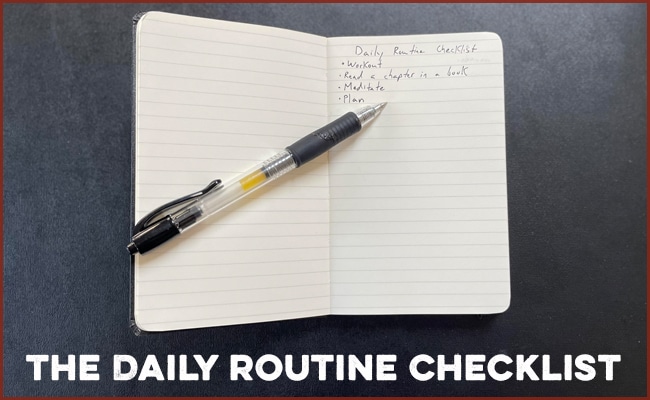
Over the years, I’ve tried to implement various morning and evening routines.
The goal of these routines was to get more of the important things done and provide a rhythm to my life.
I can still flip through the pages of my journals and see the various detailed outlines of my routines:
Morning Routine
5:30 AM: Wake up; meditate and pray
5:40 AM: Scripture study
6:00 AM: Journal
6:20 AM: Workout
7:30 AM: Breakfast
Evening Routine
9:30 PM: Review day’s work; review goals (long-term and short-term); plan tomorrow’s schedule
10:00 PM: Get ready for bed
10:30 PM: Read a book
11:00 PM: Lights out
After I’d crafted a routine, I’d stick to it pretty religiously for a week or two.
But, invariably, something would pop up that would throw a wrench into the whole thing.
Vacations.
Work emergencies.
Unexpected (yet fun!) late-night meet-ups with friends.
A car that had to be taken into the shop early in the morning.
Sick kids.
Because my routines were so optimized, if I was off just a little on the timing, it would throw the entire schedule into disarray. If I didn’t get up at precisely 5:30 AM, I wouldn’t be able to do everything in my morning routine.
And because I set such a high standard for what a daily routine was to look like, anything short of it felt like a failure. Routines create all-or-nothing thinking. “Well, I can’t get my meditation in at 5:35; what’s the point of trying to do anything else?”
I liked the idea of routines, but they weren’t working for me.
A couple of years ago, after my umpteenth time failing at sticking to a strict morning and evening routine, I decided to try something different. I created a “routine checklist” — a set of things (separate from my work and mega, river-esque checklists) that I wanted to do every day.
It didn’t matter when I did these things. I was good if I got them done before I turned in for the night.
A lot of the tasks on my daily routine checklist are the same tasks that were in my hyper-structured morning and evening routines:
Reading
Meditation/prayer
Planning
Exercise
The only difference is I don’t have a set time for when I take care of these tasks. I can do them whenever I want.
Can’t exercise first thing in the morning?
No big deal. Do it in the evening, even if it means you have to modify your workout.
Going out that night and won’t have time to read?
Not a problem. Get in a few snatches during the day when you take breaks from work.
Highly-structured routines are fragile. They’re so rigid that any slight disturbance can cause them to crack.
The routine checklist is flexible. It can shift to fit the changing landscape of each day. And that flexibility results in more consistency.
Since shifting to the daily checklist, I do more of the good things I want to do, more regularly. It eliminates the all-or-nothing thinking that comes with strict routines. So I can’t pray and read my scriptures first thing in the morning? Who cares? I’ll do it during lunch.
Other people have noticed the same thing I’ve noticed about routines. When AoM podcast guest Madeleine Dore set out to interview hundreds of creatives and entrepreneurs about their routines, she figured she’d find that they followed pretty set schedules. Instead, she discovered that most of them didn’t have a structured routine. As Madeleine put it, they went about tackling their days and their tasks in “higgledy-piggledy” fashion. And yet were successful nonetheless. There’s power in higgledy-piggledy.
If your highly structured morning and evening routines are working for you, fantastic. Keep doing them.
However, if you’re like me and the structured routines aren’t working, try the daily checklist.
Create a list of 3 to 5 important things you’d like to do every day. Don’t go crazy with this. Keep the list short.
I keep my daily routine checklist in Todoist (here’s how I use Todoist to organize my work and life in general). It allows me to create recurring daily tasks. I have a list called “Daily” that keeps my daily checklist. You can use the note app that you prefer. Or write the list on an index card.
Then do those things when you can throughout the day. Look for the possibilities in spare moments to fit them in.
That’s it.
If you can’t get all the items on your list done, don’t sweat it. Life happens. Try again tomorrow. The list will be waiting.
For more insights on how to be productive and creative, without following a strict routine, listen to our podcast with Madeleine Dore:
The post Routines Not Working For You? Try a Daily Checklist appeared first on The Art of Manliness.
0 Commentaires